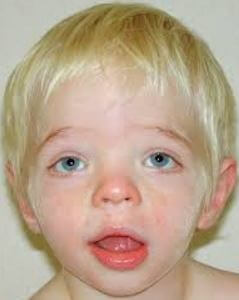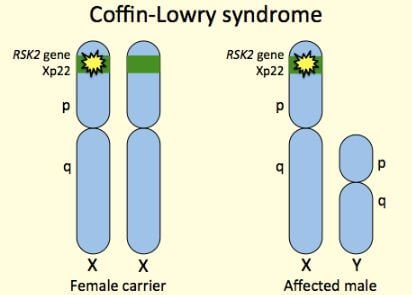Coffin Lowry Syndrome
What is Coffin Lowry Syndrome?
Coffin Lowry syndrome is an X-linked genetic disorder, occurs due to Mutations in the RSK2 gene. Coffin Lowry syndrome affected individuals have severe mental retardation and atypical facial and skeletal system malformation2,4.

Symptoms
Male members with Coffin Lowry syndrome have more severe symptoms associated with the condition. Sometimes affected female members have no symptoms, whereas some females may have severe symptoms as similar as male affected individuals.
Facial Features
Atypical facial features are easily distinguishable for Coffin Lowry syndrome affected individuals. The included facial characteristics are:
- Both the temples are tapered
- well-defined forehead and eyebrows
- very limited hair in the scalp
- Thicken hairline eyebrows
- Eyelid slits are inclined downwards
- expanded eyes
- Wide nasal bridge and the septum of the nasal cavity is thickened
- Opened oral cavity
- Lips are prominent and thick
- Prominent ears and chin
Skeletal System Malformation

- Different skeletal structures in the body have several abnormalities, like thickening of facial bones, shorten the length of the long bones, breastbones are pointed.
- Abnormal spine curvature may occur side to side or front to back.
- Affected individuals usually have short physique
- Head size is smaller than the normal (microcephaly)
- Dental structure abnormality
- Hands bones are thin and elongated
- Double-jointed thick fingers with tips are tapered
- Hypothenar
- Big and shorten toe
Other Abnormalities
Coffin Lowry syndrome affected individuals may have hearing loss, vision loss etc. The associated cardiac problem often provides a fetal outcome.
Mental Abnormality
Almost every individual with Coffin Lowry syndrome is mentally retarded. Females with Coffin Lowry syndrome may have normal intelligence, however, some have severe mental retardation. Severely affected individuals even unable to develop speech ability.
In an emotional moment, or exposure to unexpected noise can cause the brief collapse to the patients, however, without loss of consciousness4,5.
Causes
Mutation of RSK2 and RPS6KA3 gene on the X-linked chromosome at plotted on Xp22.2-p22.1 chromosomal sequence is a primary pathological abnormality causing Coffin Lowry syndrome. But experts also reported that in some cases RSK2 gene mutation is not detectable in Coffin Lowry syndrome.

In the human body, chromosomes are responsible for carrying genetic information. A set of 23 pairs of chromosomes present in human body, among them one pair is considered as sex chromosome. In the male, the sex chromosome pair is made with one X and one Y chromosome, whereas in female two X chromosomes made a sex chromosome pair. A short (p)and a long (q) arm present in each chromosomal structure.
In Coffin Lowry syndrome is an inherited disorder, in which an X-linked dominant genetic trait get affected. But, this disease may not be hereditary, as approximately, 70-80 percent of affected individuals do not have a family history. Therefore, Coffin Lowry syndrome can be an acquired condition.
Coffin Lowry affected male individuals have an RSK2 gene mutation and produce multiple symptoms at the early age. Whereas, female patients with an RSK2 gene mutation usually develops mild physical symptoms at their late phase of life3,5.
Diagnosis
Different clinical diagnostic tools are applied to detect the Coffin Lowry syndrome.
Cultured serological testing in the laboratory showed that reduce the functioning of the ribosomal S6 kinase activity in the fibroblast and lymphoblast cells transformation found in affected male individuals.
Neuroimaging studies and X-ray imaging tools are used to detect the skeletal system and other abnormalities.
The specimen is collected from blood sample or cells can collect from a cheek swab to conduct molecular genetic testing. This test report provides information about RSK2 gene mutation. This is a confirmatory test for detection of Coffin Lowry syndrome. But some individuals with Coffin Lowry syndrome do not possess a detectable mutation2,3,5.
Treatment
Coffin Lowry syndrome has no definite treatment. But the aim of the treatment is to provide relief from symptoms and provide supportive care. Routine check up for cardiac activity, visual and hearing examinations.
The progressive condition of Kyphoscoliosis (a combination of musculoskeletal malformation which provides abnormal curvature in the spine) needs to monitor, as it often provides life-threatening outcome like compromised cardio-respiratory functioning.
Clonazepam is an antiepileptic medication usually prescribed to control convulsion.
Genetic counseling is recommended for providing supportive care to patients and caregivers3,4,5.
Life Expectancy
The exact data is not available due to the scarcity of the medical reports. However, affected males have shorter life expectancy than females. Females affected individuals can survive until their old age. A different case report showed male affected individuals usually enjoy their life at the age of 26 years and that can expand to 35 years. Usually, male patients with more than 35 years age gradually deteriorate their condition and confined to bed, incontinent, and unresponsive.
The usual cause of death is myocarditis, pneumonia or severe convulsive disorders. Complications related to general anesthesia usually affects during surgical intervention for correction skeletal system malformation or dental extraction2.
Facts
- Coffin Lowry syndrome is a rare genetic disorder
- RSK2 gene mutation is main cause of Coffin Lowry syndrome
- Mental retardation is main characteristic feature;
- Craniofacial abnormalities along with various skeletal abnormalities are clinical presentation of Coffin Lowry syndrome
- Both male and female genders can develop Coffin Lowry syndrome, but the symptoms severity are more prominent in male individuals1,2,3
References
- Coffin Lowry Syndrome; WebMD; http://www.webmd.com/children/coffin lowry-syndrome
- A Hanauer, I D Young; Coffin Lowry syndrome: clinical and molecular features;http://jmg.bmj.com/content/39/10/705
- Coffin Lowry syndrome; Genetic and Rare Disease Information Center;https://rarediseases.info.nih.gov/diseases/6123/coffin lowry-syndrome
- Coffin Lowry syndrome; Genetic Home Reference;https://ghr.nlm.nih.gov/condition/coffin lowry-syndrome
- Coffin Lowry Syndrome; National Organization for Rare Disorders;https://rarediseases.org/rare-diseases/coffin-lowry-syndrome/
